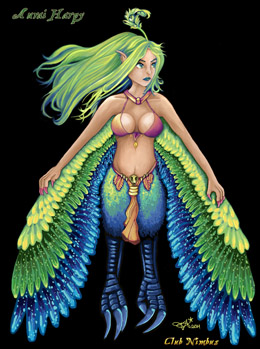
Aurai Harpies
- Height: 4'7"-5'3" (1.5 meters) with Males slightly taller.
- Weight: 45-75 lbs. (20-34 kg).
- Wingspan: 8.5 feet (2.5 meters).
- Diet: Carrion, Fish, Meat.
- Lifespan: 35-75 years for females; 18-30 for males.
Harpies on Nimbeterra are known as Aurai Harpies, named after the Aurai winged nymphs of Greek Mythology. The Aurai are spread wherever they can find a home. Their groups are lead by a matriarch, who is usually the eldest of their flock with the next eldest taking over as she passes. They value wit and wisdom, but value property little because of their transient nature.
Harpies are incredibly vain and keep themselves and their nests meticulously clean, keeping waste far away from their living areas. This isn't without its downsides, their filthy reputation comes from them using homes of those who have upset them greatly as a lavatory for their flock.
Nests are often communal or separate depending on the needs of a flock, usually round, and setup as an individual home based on living arangements, but large communal nests are not unheard of. Cliff faces, large trees, and any space located well off the ground are preferred, making their colonies easier to protect.
Property is mostly communal, aside from items each harpy can carry on her person. Anything else is passed on for whoever needs it in the flock. They are notorious for being theives, taking things as they need them, and expecting others to do the same.
Those who befriend them often find that harpies are more than happy to share and help other women of all species with their needs, as long as they are respected and allowed to take what they need in turn.
Those who retaliate against the Aurai live to regret it, as harpies enjoy finding creative ways to make enemies of the flock miserable, and they take great joy in crafting creative insults and taunting those who upset them. Throughout history, it has been thought that male Harpies are either extremely rare or outright don't exist at all. This is now known to be false. The most distinctive feature separating the sexes is the prominent feather quill on the top of their head, growing from the hairline. Males do not possess this trait. Additonally, the tails of both males and females are small and diamond-shaped, with females generally having a more broad tail. Aside from this, male harpies are nearly identical to their female counterparts which causes some confusion for those outside of their clan. Males tend to be mild earth tones, usually blending well with their surroundings, while females tend to be flamboyant, with plumage being a wide variety of colours from the rainbow. Male births are quite rare, and their identities carefully guarded from outsiders. Males are seen as normal "sisters" of their clutches and rarely know they are different until it's time to reproduce. For one weekend following the harvest moon, sexually mature Harpies join in a large group mating ceremony where the male, for once, is paid special attention. Each group consists of one male to 40-220 females over the course of three nights. The exhausted male frequently succumbs to extreme fatigue and dehydration after the weekend-long ceremony.
The gravid females collect as much nesting material as they can before the first snow, proceeding to then hide away in their nests and sleep for up to 22 hours a day. It is not a true hibernation as their heart rate and body temperature do not drastically change, they can be roused easily from sleep and still need to eat. They lay their clutch in the spring and the young Harpies hatch 46 days later. The young are born with soft, fluffy down feathers and unable to fly until age 2-4. They are fed breastmilk and gradually weaned off with tenderized meat as their flight feathers come in. Habits
Society
Dimorphism
Breeding